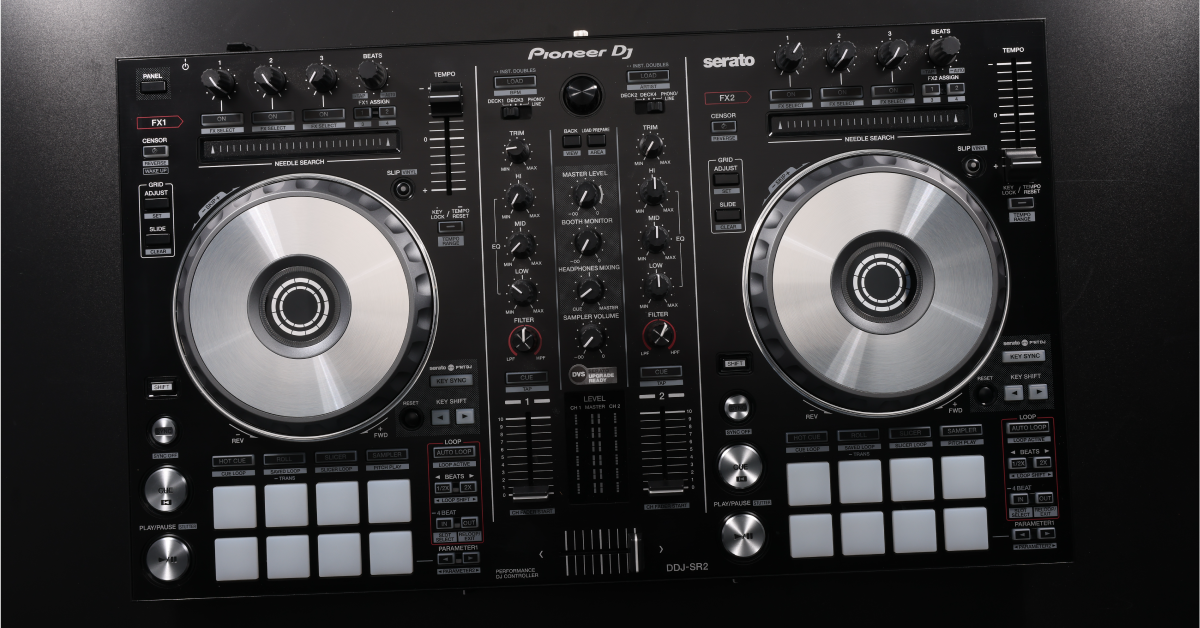How to Set Up DJ Controllers

Now that you learned the DJ controller’s ins and outs in our DJ Controller Getting Started Guide, what’s next? You need to learn how to set up and connect the audio hardware to your DJ controller. We’ll cover the common connections in this guide, but for more information on your controller’s advanced output connections, be sure to check out its owner’s manual for more information! Follow the sections below to get started.
DJ controller audio connections
From entry-level to high-end, the most standard audio output connection you’ll see on a DJ controller is RCA, which is an unbalanced signal. Your audio connections are all dependent on your setup and the venue.
For example, if you’re only connecting your DJ controller to your computer speakers, using a short RCA cable setup of 5–10 feet is perfectly fine. However, the longer the RCA cable runs and the farther the speakers (or mixer) are from you, the greater the amount of signal loss and interference. If this is the case, you’d need to use something like a line-level shifter or DI box to balance the output so you can send it longer distances without signal loss.
Before we begin
DJ controllers are line-level sources, so do NOT connect its output to a phono input. Doing so will amplify an already amplified signal. It will produce a very loud, distorted sound and can damage your speakers. Also, be sure to turn everything down before connecting your DJ controller. Connecting it while the volume is up could result in loud pops and may also cause damage.
Booth outputs
Booth outputs are a second set of outputs that let you hear the same signal coming out of the mains and are an excellent feature to have on your DJ controller. If you’re not next to the mains, then you’re prone to delay throwing your performance off, like DJing behind the mains or in a booth where the mains are on the other side of the room. Having a speaker (or speakers) right next to you connected via the booth outs will eliminate the problem of delay.
- When using booth outputs, it’s best to use the RCA to XLR or RCA to TS cables to connect.
Mic and headphones
The microphone connection is pretty easy to understand. If you’re going to get the crowd to dance while you’re using a mic, talk into the mic at performance level during soundcheck while some tracks are playing so you can find the right balance between your mic and the music.
Another set of levels to consider are for headphones. In our DJ Controller Getting Started Guide, we discussed how working with headphones is essential, especially with headphone cueing. It may take a little practice finding the right level, since you’ll hear two different tracks at once, but getting it just right can help you determine which song is which.
- If you can’t hear anything through your headphones and you have everything routed correctly, always check the front and back of the DJ controller. There’s usually a small volume knob located next to the jack; its master volume is often overlooked and may be turned down.
Mic & Aux In
Live sound mixer
BEFORE THE GIG: If you know that you’re playing a gig and you have to use their sound setup, call ahead and make sure you have all the right cables. Also, always include additional cables in your gig bag. The venue may not have any cables that work (or any at all), so being prepared will keep your gig on track and put your mind at ease.
If you’re in a live situation, you’ll more than likely connect to a sound mixer. Unless the sound mixer is located right next to you and can convert the RCA’s unbalanced signal into a balanced one, you’ll need a few additional pieces of gear in your gig bag:
- An active DI box or audio interface. This converts the unbalanced signal of your DJ controller to a balanced input on the live mixer. Passive DI boxes can also do the trick, but depending on the cable run, you might run into signal loss.
- RCA to ¼-inch cable to connect from your DJ controller outputs to a DI box input.
- Cables with connectors that match the ones you’ll be plugging into on the mixer (XLR to XLR, etc.).
To connect your DJ controller to a live sound mixer, all you need to do is connect the RCA to ¼-inch cable from your DJ controller to a dual-channel active DI box. Next, use the XLR to XLR (or TRS to TRS) cables to connect to your mixer.
- Most DJ controllers have built-in sound cards, but audio interfaces are preferred in live situations for better sound.
PA speakers
When you’re connecting directly to PA speakers, you’ll need to make sure the speakers are powered. If they’re powered, you can connect using the standard RCA to ¼-inch cable. If they’re passive (meaning they don’t have internal power amps), you’ll first need to connect the speakers to a dedicated power amp. Once the speakers are powered, then you can make your connections.
If this is your first time setting up in a live situation, check out our guides on how to set up a PA system!
Setting Up
DJ controller computer connections
Like we talked about in our DJ Controller Getting Started Guide, DJ controllers are almost always connected to a computer and use special DJ software, such as Serato or Rekordbox, to operate the controller.
Connect to speakers
This is the easiest and most common setup when you’re at home because you simply need to connect the RCA outputs on your DJ controller to the RCA inputs on your computer speakers. If your computer speakers don’t have RCA inputs, then you may need to get a few RCA to XLR or RCA to TS cables to connect.
Connect to computers
You just need to use the included USB cable to connect the DJ controller to your computer. Once connected, you’ll need to launch the DJ software, then configure the controller so it’s recognized. After that, you’ll be all set!You may need additional drivers or updated firmware for it to work correctly, so double-check the manufacturer’s support page to see if you’ll need it or not.
When it comes to connections, we recommend hooking up your DJ controller directly to your computer and using its included power supply (if applicable). Connecting controllers to USB hubs, mainly passive ones, may not provide enough power to transfer data from the DJ controller.
Also, be sure to check out our PC and Mac optimization guides to make sure you get the best performance possible before you get onstage!
Related Articles
When you need help, Sweetwater has the answers!
Our knowledge base contains over 28,000 expertly written tech articles that will give you answers and help you get the most out of your gear. Our pro musicians and gear experts update content daily to keep you informed and on your way. Best of all, it’s totally FREE, and it’s just another reason that you get more at Sweetwater.com.


